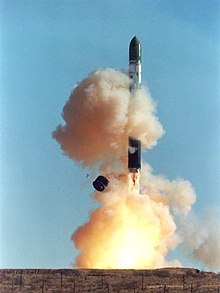Heavy ICBM

Heavy ICBM is a term that was created in the 1970s to describe a class of Soviet and Russian ICBMs (intercontinental ballistic missiles).[1] They were characterized by a heavy throw-weight of 60 to 90 metric tons, several times that of an LGM-30 Minuteman, and a length of over 35 meters, and were thus capable of delivering a large number of warheads in a single MIRV missile.
This term usually refers to R-36 / "SS-9 Scarp",[2] R-36M (SS-18) variants / "SS-18 Satan",[1][3] and the RS-28 Sarmat missiles.
RS-28 Sarmat is called a "superheavy" ICBM.[4] Superheavy ICBMs date back to the UR-500 which was designed to deliver the 50 megaton (potentially, 100 megaton) Tsar Bomba warhead. The UR-500 was developed into the Proton which successfully launched the first living beings to orbit the Moon and return safely, on Zond 5.
Deliveries
[edit]The SS-9 was a silo-launched missile capable of delivering warheads of 5–18 megatons, with a range of up to 15,500 km.[5] These were then replaced by the similar SS-18, with payloads of 18–25 megatons. The silos used for launching were the same for both, once modified.
References
[edit]- ^ a b Graham, Thomas Jr.; Damien J. La Vera (2003). Cornerstones of Security: Arms Control Treaties in the Nuclear Era. University of Washington Press. pp. 336 et al. ISBN 9780295982960.
- ^ "R-36 / SS-9 SCARP". www.fas.org. Retrieved 19 October 2012.
- ^ "R-36M / SS-18 SATAN". www.fas.org. Retrieved 19 October 2012.
- ^ Gady, Franz-Stefan. "Russia Upgrades Facility to Produce RS-28 Sarmat ICBM". thediplomat.com. Retrieved 2021-01-06.
- ^ "SS-9". www.missilethreat.csis.org. Retrieved 19 October 2012.
